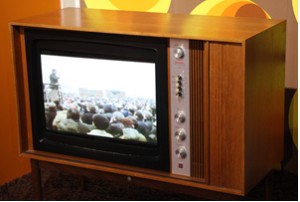Television in the 70s

Colour television was the big change of the 70s. Colour broadcasts started as early as 1968, but it was in the 70s, that colour TV really took off. By 1972, there were 1.6 million licences for colour television, but even then 15 million people were still watching TV in black and white.
In the 70s there were fewer channels than today, just BBC1, BBC2 and ITV. This allowed the talents of writers and actors to concentrate on fewer programmes. As there was less television, some shows had huge audiences compared with those of today. Some of the classics of television comedy and drama come from this era.
70s Sitcoms
This is our selection of some of the classic comedies of the 70s. Most are wonderfully funny, all provide a valuable insight into life in the 70s and a chance to relive past memories.
Retrowow reviews 70s sitcoms:
Whatever Happened to the Likely Lads?
Whatever Happened to the Likely Lads? was a sequel to The Likely Lads, a long running series about two Jack the Lads about town, Bob Ferris (Rodney Bewes) and Terry Collier (James Bolam).
Five years have passed and Terry has been in the Army. He returns home to Newcastle to find it a much changed city: streets demolished and new flats being built. Bob is engaged to marry Thelma Chambers and they have purchased a new semi-detached home on the Elm Lodge Housing Estate. The permissive society has passed Terry by. Bob takes him on a tour of Newcastle, including the famous Get Carter Car Park.
The programme has a strong theme of recapturing lost youth echoed in the programme's theme tune, with the line "the only thing to look forward to - the past". There are also some strong pointers to life in the 70s. Bob has become middle class. He enjoys meals out, the badminton club and owns a car, a Vauxhall Viva. Terry is very much true to his working class roots, though for most of the series he is unemployed. Both go out drinking on a Friday night; usually pints of 'special' which looks like mild.
Nevertheless, there are some clear signs of progress. Bob enjoys a curry. Terry prefers egg and chips. Indian food still had an air of sophistication in the early seventies. No doubt, had the show been made today Terry would been a lager and vindaloo man.
Bob also talks about organic food. This seems very advanced for the 70s. May be in some trendy quarter of London, but Newcastle in the early 70s.....
The Liver Birds
The Liver Birds tells the story of two young women who share a flat in Liverpool. They are, in the original series Dawn (Pauline Collins) and Beryl Hennessey (Polly James). Later Dawn leaves and it's Beryl and Sandra Hutchinson (Nerys Hughes). Finally Beryl leaves and Carol Boswell (Elizabeth Estensen) becomes Sandra's new flatmate.
This was a new way of life in the sixties. The girls shared experiences of work, fashion, eating out and mostly men, or fellas, as Beryl preferred to call them. The series was set in Liverpool, still at the height of its Beatles fame. Its swinging sixties and early seventies trendiness was sealed by the series theme tune is by the Scaffold, of Lily the Pink fame.
The Liver Birds depicts ordinary life for young people in the early seventies. It story lines centre around the girls' search for suitable boyfriends, and sometimes how to get rid of unsuitable ones. It is a female equivalent of the Likely Lads, set on the other side of the country.
The Liver Birds was written by Carla Lane and Myra Taylor. In spite of Carla Lane's later output, some of the plots are weak. It is great for nostalgic viewing, but does not match up the Whatever Happened to the Likely Lads?.
Bless this House
In Bless this House, the main theme is the generation gap between conservative salesman, Sid Abbot (Sid James) and his teenage son, Mike (Robin Stewart) and daughter, Sally (Sally Geeson). Mike has long hair and wears beads and Sid is worried that he is not interested in girls. Nothing could be further from the truth.
Bless this House is an insight into the life of a middle class, rather than ordinary, family in the 70s. Sid Abbot is a successful salesman who earns good money. His philosophy is that hard work pays off. His children think they should do their own thing. It is a recipe for family conflict. Sid's wife Jean (Diana Coupland) sits in the middle. Her attitude to the new generation is much more tolerant.
Bless this House gives a wonderful insight into the attitudes of the different generations at the close of the sixties. The humour, particularly in some of the early episodes, is a little dated.
Fawlty Towers
Fawlty Towers is John Cleese's classic comedy about a Torquay hotel. I can remember watching this series the first time round in the 70s and have never tired of it. It's packed with humour from beginning to end of each episode.
John Cleese's portrayal of Basil Fawlty was based on his real life experience of staying at the Gleneagles Hotel in Torquay. Basil Fawlty would be happy running the hotel if it were not for the inconvenience of the guests. He is unbelievably rude to all nationalities from Germans to Americans. He loathes and despises young and old alike.
Basil Fawlty is forever nagged by his overbearing wife Sybil (Prunella Scales). In the dining room, Spanish waiter Manuel's (Andrew Sachs) incompetence and poor English combine with Basil's rudeness to make every guest's stay unbearable. Only the long suffering Polly (Connie Booth) keeps the Hotel going.
Fawlty Towers must rank among the comedy greats. I can't remember laughing at anything so much!

